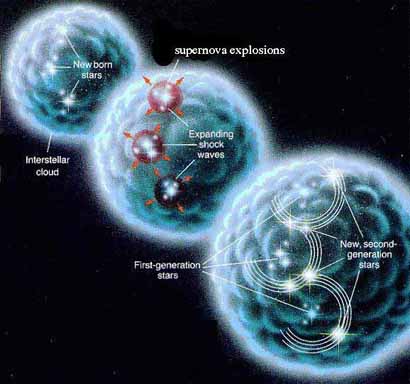Star Life Cycles - An Endless Cycle
Stars and NebulaeIndex
Interstellar Clouds Questions Credits Links Michael Gallagher August 2002 July 2007 |

From J Schombert's Astronomy 122 Lecture Notes, University of Oregon
Stars condense from molecular clouds.
They fuse hydrogen for most of their lives.
When that is exhausted, if they are massive enough, they fuse heavier elements.
Throughout their lives, they expel matter back into the surrounding interstellar medium via their stellar winds.
When all fusible matter is exhausted, their cores form white dwarfs, neutron stars or black holes.
When a white dwarf forms, the star's outer atmosphere drifts off into the interstellar medium as a planetary nebula.
When a stellary core collapses to form a neutron star or a black hole,
a violent supernova explosion creates a massive debris cloud.
Material synthesised in stars is injected back into the interstellar medium
to form new molecular clouds, enriched in heavier elements.
Pressure waves generated by star formation regions stimulates the collapse of outlying molecular clouds
and the cycle of birth, life and death of stars commences again.
|
